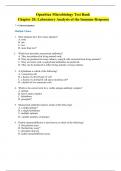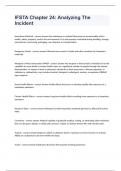Exam (elaborations)
OpenStax Microbiology Test Bank Chapter 20: Laboratory Analysis of the Immune Response
- Course
- Institution
OpenStax Microbiology Test Bank Chapter 20: Laboratory Analysis of the Immune Response * = Correct answer Multiple Choice 1. Most antigens have how many epitopes? A. none B. one C. two D. more than two* 2. Which best describes monoclonal antibodies? A. They are produced in living anima...
[Show more]












